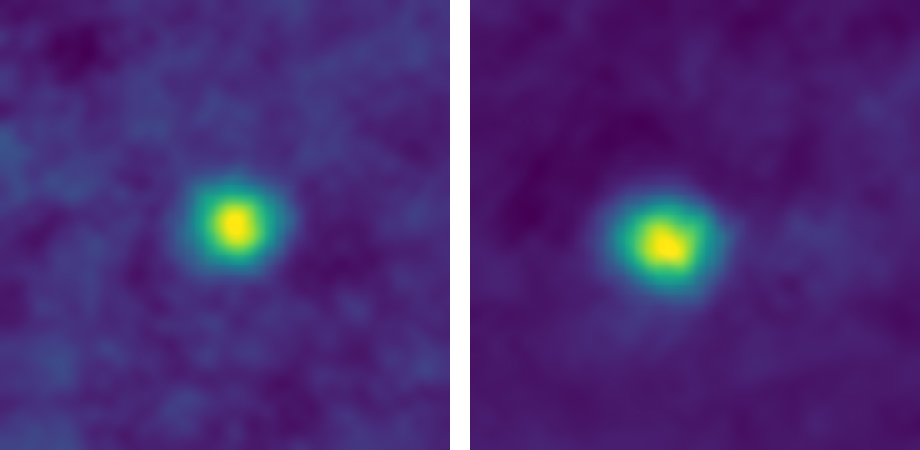3.79 billion
miles away in the inky blackness of space, NASA’s New Horizons
spacecraft snapped two pictures and transmitted those images back to
Earth. New Horizons’s December 2017 photoshoot now holds
the record of being the farthest away a camera has ever been from our
planet. The previous record was the famous ‘Pale Blue Dot’ image, taken by the probe Voyager 1 when it
was 3.75 billion miles away in 1990.
New Horizons
used its Long Range Reconnaissance Imager (LORRI) to photograph
two objects in the Kuiper belt, a cluster of dwarf planets — including Pluto —
and space rocks at the fringe of our solar system. The Kuiper
belt contains celestial leftovers from the birth our solar system. So
while the images of 2012 HZ84 (on the left) and 2012 HE85 might not
look like much, they can provide insights into the beginnings of our solar
system.
used its Long Range Reconnaissance Imager (LORRI) to photograph
two objects in the Kuiper belt, a cluster of dwarf planets — including Pluto —
and space rocks at the fringe of our solar system. The Kuiper
belt contains celestial leftovers from the birth our solar system. So
while the images of 2012 HZ84 (on the left) and 2012 HE85 might not
look like much, they can provide insights into the beginnings of our solar
system.
Two objects
in the Kuiper belt. Credits: NASA/JHUAPL/SwRI.
in the Kuiper belt. Credits: NASA/JHUAPL/SwRI.
Simon
Porter, an astrophysicist at Southwest Research Institute in Colorado who is a
member of the New Horizons mission, characterized the images as being results
of a “test run” in an interview with The Washington Post. That’s why
the image of 2012 HE85 is slightly off-center in the picture above.
Porter, an astrophysicist at Southwest Research Institute in Colorado who is a
member of the New Horizons mission, characterized the images as being results
of a “test run” in an interview with The Washington Post. That’s why
the image of 2012 HE85 is slightly off-center in the picture above.
Currently,
the Hubble Space Telescope orbiting Earth is able to
produce more detailed images of most Kuiper Belt objects than New Horizons’s
LORRI, according to Porter. But not for long.
the Hubble Space Telescope orbiting Earth is able to
produce more detailed images of most Kuiper Belt objects than New Horizons’s
LORRI, according to Porter. But not for long.
New Horizons
is actually on its way out of our solar system, traveling about 700,000 miles a
day away from us. The spacecraft switches between active and dormant modes to
save fuel, and was most recently “on” between August and December 2017, when it
shot the aforementioned images.
is actually on its way out of our solar system, traveling about 700,000 miles a
day away from us. The spacecraft switches between active and dormant modes to
save fuel, and was most recently “on” between August and December 2017, when it
shot the aforementioned images.
The next
time New Horizons wakes up — in summer of 2018 — the images it beams back from
the Kuiper belt will be better quality than those captured by the Hubble, The
Washington Post reports.
time New Horizons wakes up — in summer of 2018 — the images it beams back from
the Kuiper belt will be better quality than those captured by the Hubble, The
Washington Post reports.
As New
Horizons continues to send us information about the far reaches of our solar
system, scientists will analyze the images to improve our understanding of the
shape and surface properties of these distant objects. The photographs will
also help scientists check for moons, and whether these celestial objects have
rings like Saturn and Uranus.
Horizons continues to send us information about the far reaches of our solar
system, scientists will analyze the images to improve our understanding of the
shape and surface properties of these distant objects. The photographs will
also help scientists check for moons, and whether these celestial objects have
rings like Saturn and Uranus.
Whether New
Horizons can help scientists locate the elusive, almost-mythical Planet Nine,
or simply offer more insight into what objects are like in this
distant region of space, it’s clear this spacecraft will continue
enhancing our knowledge about the farthest reaches of our solar system.
Horizons can help scientists locate the elusive, almost-mythical Planet Nine,
or simply offer more insight into what objects are like in this
distant region of space, it’s clear this spacecraft will continue
enhancing our knowledge about the farthest reaches of our solar system.
References: Sci News, NASA, The Washington Post
Article originally published on Fututrism.



